Psychology Lab Report: Introduction to the Human Mind
VerifiedAdded on 2023/04/07
|6
|1146
|184
Report
AI Summary
This psychology lab report delves into the complexities of the human mind, specifically focusing on inattentional blindness. The report begins with a general overview of the topic, highlighting its relevance in everyday life, including potential impacts on accidents and legal ramifications. It then provides a critical review of existing literature, discussing the limitations of past research and the need for more dynamic and naturalistic studies. The study aims to examine inattentional blindness affecting variables, including a comparison with change blindness, and the role of attention. The rationale and aims of the study are clearly defined, addressing gaps in previous research and formulating two key hypotheses regarding the perception and representation of visual world details and the role of attention. The report concludes with a list of relevant references supporting the research.
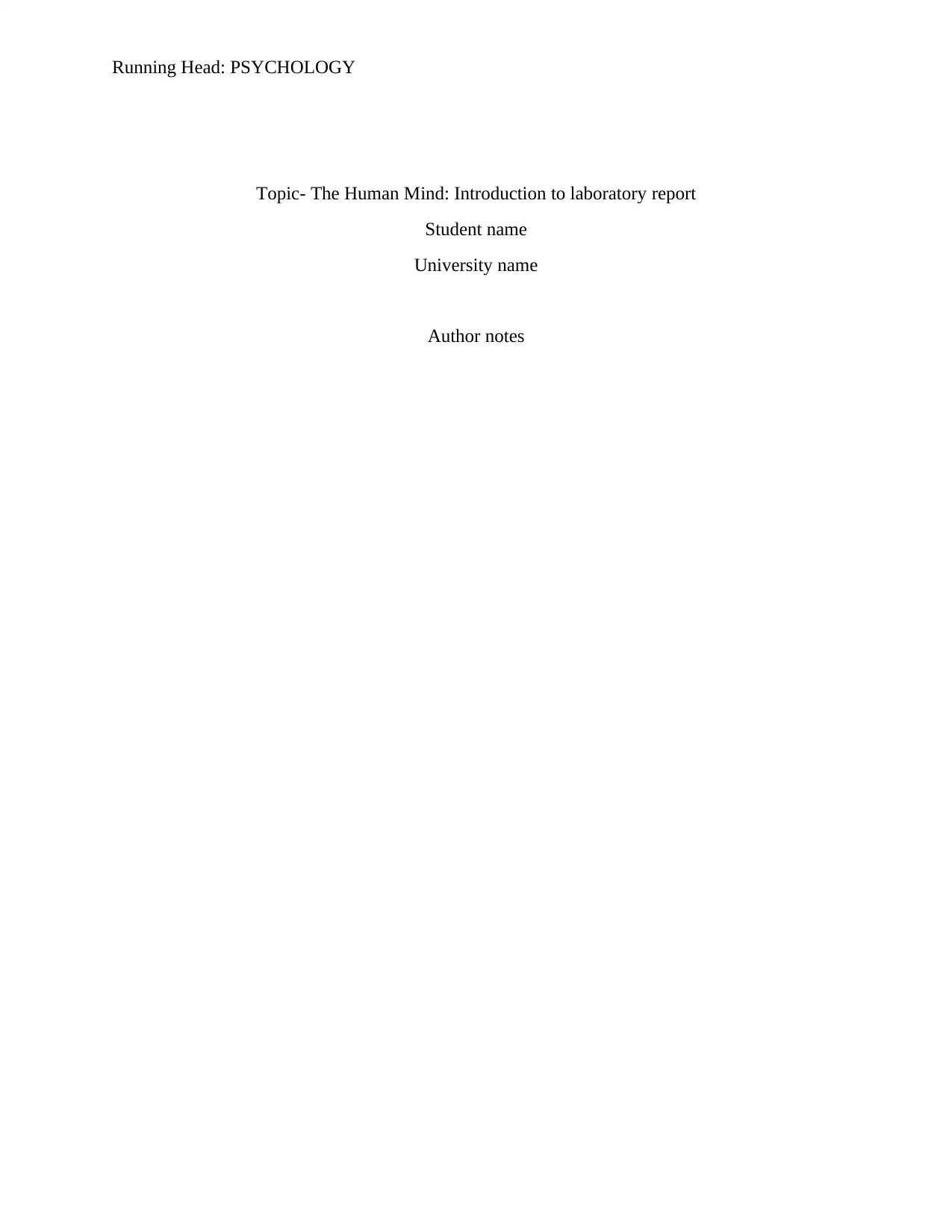
Running Head: PSYCHOLOGY
Topic- The Human Mind: Introduction to laboratory report
Student name
University name
Author notes
Topic- The Human Mind: Introduction to laboratory report
Student name
University name
Author notes
Paraphrase This Document
Need a fresh take? Get an instant paraphrase of this document with our AI Paraphraser
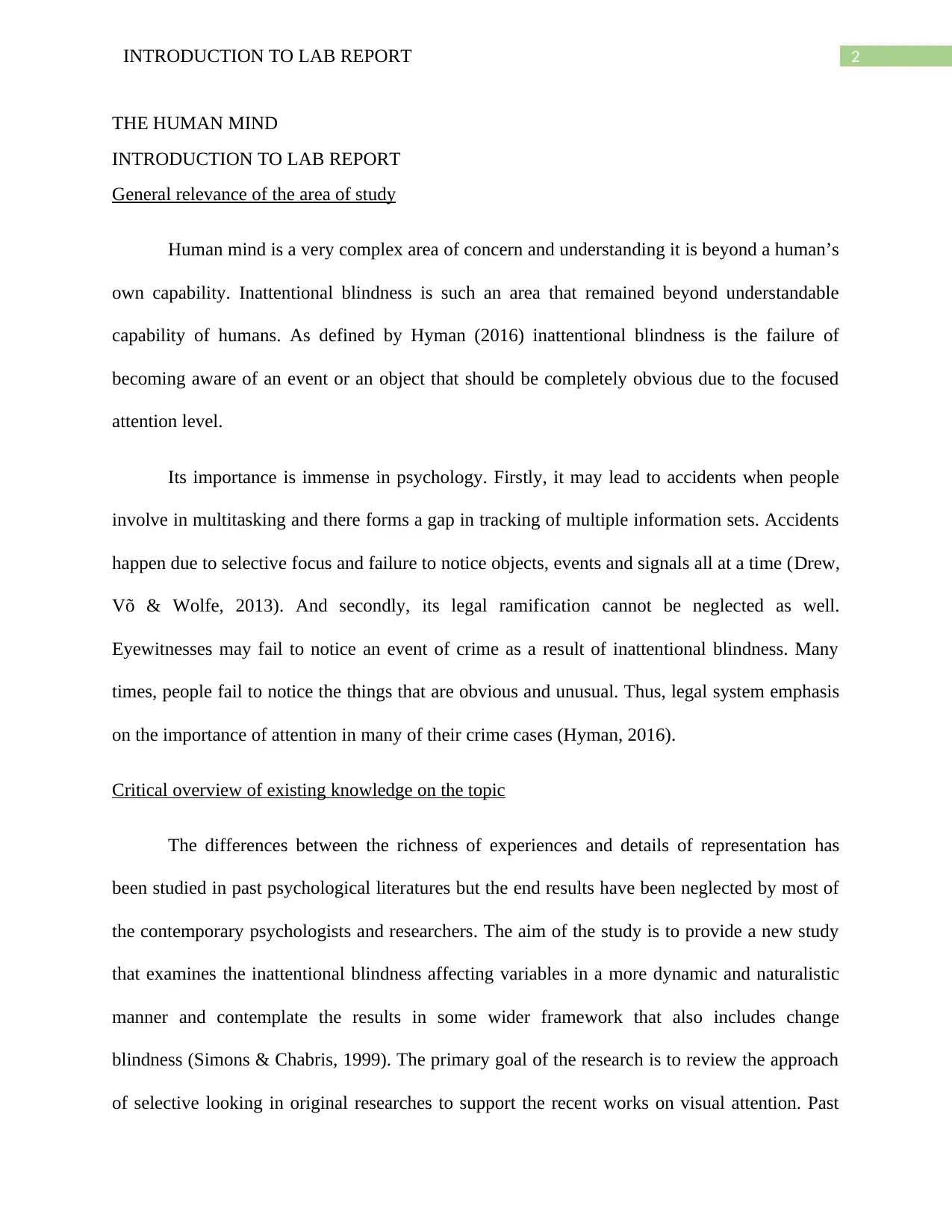
2INTRODUCTION TO LAB REPORT
THE HUMAN MIND
INTRODUCTION TO LAB REPORT
General relevance of the area of study
Human mind is a very complex area of concern and understanding it is beyond a human’s
own capability. Inattentional blindness is such an area that remained beyond understandable
capability of humans. As defined by Hyman (2016) inattentional blindness is the failure of
becoming aware of an event or an object that should be completely obvious due to the focused
attention level.
Its importance is immense in psychology. Firstly, it may lead to accidents when people
involve in multitasking and there forms a gap in tracking of multiple information sets. Accidents
happen due to selective focus and failure to notice objects, events and signals all at a time (Drew,
Võ & Wolfe, 2013). And secondly, its legal ramification cannot be neglected as well.
Eyewitnesses may fail to notice an event of crime as a result of inattentional blindness. Many
times, people fail to notice the things that are obvious and unusual. Thus, legal system emphasis
on the importance of attention in many of their crime cases (Hyman, 2016).
Critical overview of existing knowledge on the topic
The differences between the richness of experiences and details of representation has
been studied in past psychological literatures but the end results have been neglected by most of
the contemporary psychologists and researchers. The aim of the study is to provide a new study
that examines the inattentional blindness affecting variables in a more dynamic and naturalistic
manner and contemplate the results in some wider framework that also includes change
blindness (Simons & Chabris, 1999). The primary goal of the research is to review the approach
of selective looking in original researches to support the recent works on visual attention. Past
THE HUMAN MIND
INTRODUCTION TO LAB REPORT
General relevance of the area of study
Human mind is a very complex area of concern and understanding it is beyond a human’s
own capability. Inattentional blindness is such an area that remained beyond understandable
capability of humans. As defined by Hyman (2016) inattentional blindness is the failure of
becoming aware of an event or an object that should be completely obvious due to the focused
attention level.
Its importance is immense in psychology. Firstly, it may lead to accidents when people
involve in multitasking and there forms a gap in tracking of multiple information sets. Accidents
happen due to selective focus and failure to notice objects, events and signals all at a time (Drew,
Võ & Wolfe, 2013). And secondly, its legal ramification cannot be neglected as well.
Eyewitnesses may fail to notice an event of crime as a result of inattentional blindness. Many
times, people fail to notice the things that are obvious and unusual. Thus, legal system emphasis
on the importance of attention in many of their crime cases (Hyman, 2016).
Critical overview of existing knowledge on the topic
The differences between the richness of experiences and details of representation has
been studied in past psychological literatures but the end results have been neglected by most of
the contemporary psychologists and researchers. The aim of the study is to provide a new study
that examines the inattentional blindness affecting variables in a more dynamic and naturalistic
manner and contemplate the results in some wider framework that also includes change
blindness (Simons & Chabris, 1999). The primary goal of the research is to review the approach
of selective looking in original researches to support the recent works on visual attention. Past
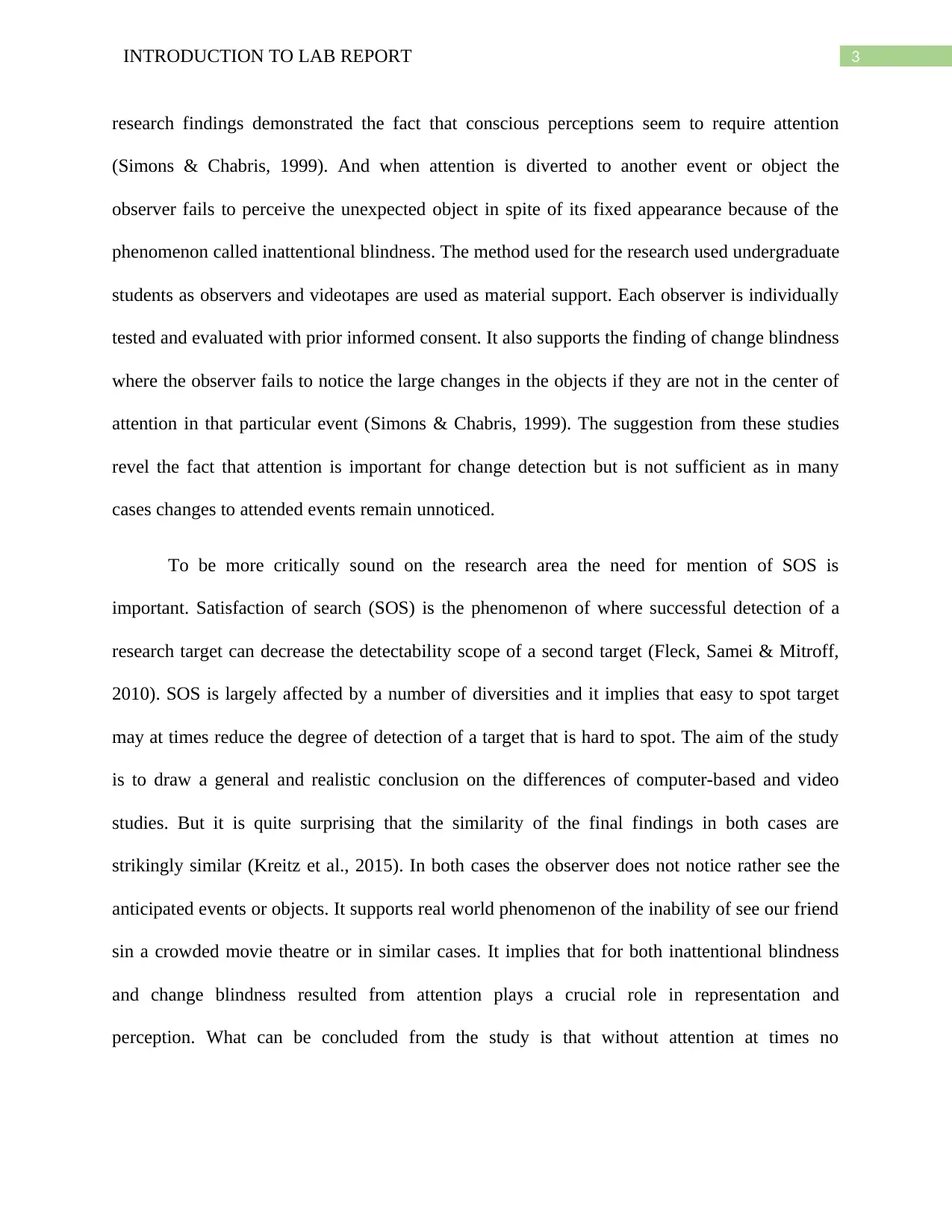
3INTRODUCTION TO LAB REPORT
research findings demonstrated the fact that conscious perceptions seem to require attention
(Simons & Chabris, 1999). And when attention is diverted to another event or object the
observer fails to perceive the unexpected object in spite of its fixed appearance because of the
phenomenon called inattentional blindness. The method used for the research used undergraduate
students as observers and videotapes are used as material support. Each observer is individually
tested and evaluated with prior informed consent. It also supports the finding of change blindness
where the observer fails to notice the large changes in the objects if they are not in the center of
attention in that particular event (Simons & Chabris, 1999). The suggestion from these studies
revel the fact that attention is important for change detection but is not sufficient as in many
cases changes to attended events remain unnoticed.
To be more critically sound on the research area the need for mention of SOS is
important. Satisfaction of search (SOS) is the phenomenon of where successful detection of a
research target can decrease the detectability scope of a second target (Fleck, Samei & Mitroff,
2010). SOS is largely affected by a number of diversities and it implies that easy to spot target
may at times reduce the degree of detection of a target that is hard to spot. The aim of the study
is to draw a general and realistic conclusion on the differences of computer-based and video
studies. But it is quite surprising that the similarity of the final findings in both cases are
strikingly similar (Kreitz et al., 2015). In both cases the observer does not notice rather see the
anticipated events or objects. It supports real world phenomenon of the inability of see our friend
sin a crowded movie theatre or in similar cases. It implies that for both inattentional blindness
and change blindness resulted from attention plays a crucial role in representation and
perception. What can be concluded from the study is that without attention at times no
research findings demonstrated the fact that conscious perceptions seem to require attention
(Simons & Chabris, 1999). And when attention is diverted to another event or object the
observer fails to perceive the unexpected object in spite of its fixed appearance because of the
phenomenon called inattentional blindness. The method used for the research used undergraduate
students as observers and videotapes are used as material support. Each observer is individually
tested and evaluated with prior informed consent. It also supports the finding of change blindness
where the observer fails to notice the large changes in the objects if they are not in the center of
attention in that particular event (Simons & Chabris, 1999). The suggestion from these studies
revel the fact that attention is important for change detection but is not sufficient as in many
cases changes to attended events remain unnoticed.
To be more critically sound on the research area the need for mention of SOS is
important. Satisfaction of search (SOS) is the phenomenon of where successful detection of a
research target can decrease the detectability scope of a second target (Fleck, Samei & Mitroff,
2010). SOS is largely affected by a number of diversities and it implies that easy to spot target
may at times reduce the degree of detection of a target that is hard to spot. The aim of the study
is to draw a general and realistic conclusion on the differences of computer-based and video
studies. But it is quite surprising that the similarity of the final findings in both cases are
strikingly similar (Kreitz et al., 2015). In both cases the observer does not notice rather see the
anticipated events or objects. It supports real world phenomenon of the inability of see our friend
sin a crowded movie theatre or in similar cases. It implies that for both inattentional blindness
and change blindness resulted from attention plays a crucial role in representation and
perception. What can be concluded from the study is that without attention at times no
⊘ This is a preview!⊘
Do you want full access?
Subscribe today to unlock all pages.

Trusted by 1+ million students worldwide
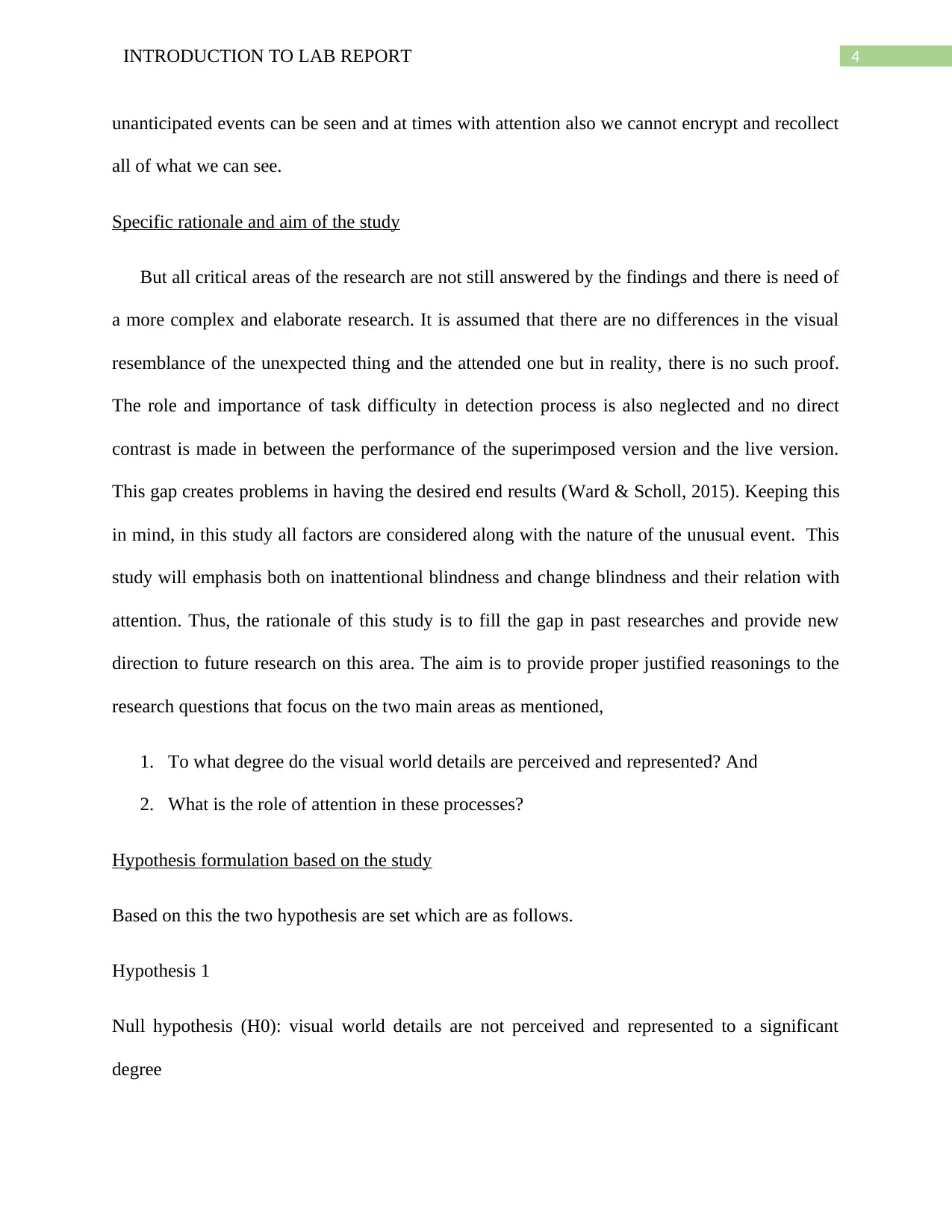
4INTRODUCTION TO LAB REPORT
unanticipated events can be seen and at times with attention also we cannot encrypt and recollect
all of what we can see.
Specific rationale and aim of the study
But all critical areas of the research are not still answered by the findings and there is need of
a more complex and elaborate research. It is assumed that there are no differences in the visual
resemblance of the unexpected thing and the attended one but in reality, there is no such proof.
The role and importance of task difficulty in detection process is also neglected and no direct
contrast is made in between the performance of the superimposed version and the live version.
This gap creates problems in having the desired end results (Ward & Scholl, 2015). Keeping this
in mind, in this study all factors are considered along with the nature of the unusual event. This
study will emphasis both on inattentional blindness and change blindness and their relation with
attention. Thus, the rationale of this study is to fill the gap in past researches and provide new
direction to future research on this area. The aim is to provide proper justified reasonings to the
research questions that focus on the two main areas as mentioned,
1. To what degree do the visual world details are perceived and represented? And
2. What is the role of attention in these processes?
Hypothesis formulation based on the study
Based on this the two hypothesis are set which are as follows.
Hypothesis 1
Null hypothesis (H0): visual world details are not perceived and represented to a significant
degree
unanticipated events can be seen and at times with attention also we cannot encrypt and recollect
all of what we can see.
Specific rationale and aim of the study
But all critical areas of the research are not still answered by the findings and there is need of
a more complex and elaborate research. It is assumed that there are no differences in the visual
resemblance of the unexpected thing and the attended one but in reality, there is no such proof.
The role and importance of task difficulty in detection process is also neglected and no direct
contrast is made in between the performance of the superimposed version and the live version.
This gap creates problems in having the desired end results (Ward & Scholl, 2015). Keeping this
in mind, in this study all factors are considered along with the nature of the unusual event. This
study will emphasis both on inattentional blindness and change blindness and their relation with
attention. Thus, the rationale of this study is to fill the gap in past researches and provide new
direction to future research on this area. The aim is to provide proper justified reasonings to the
research questions that focus on the two main areas as mentioned,
1. To what degree do the visual world details are perceived and represented? And
2. What is the role of attention in these processes?
Hypothesis formulation based on the study
Based on this the two hypothesis are set which are as follows.
Hypothesis 1
Null hypothesis (H0): visual world details are not perceived and represented to a significant
degree
Paraphrase This Document
Need a fresh take? Get an instant paraphrase of this document with our AI Paraphraser
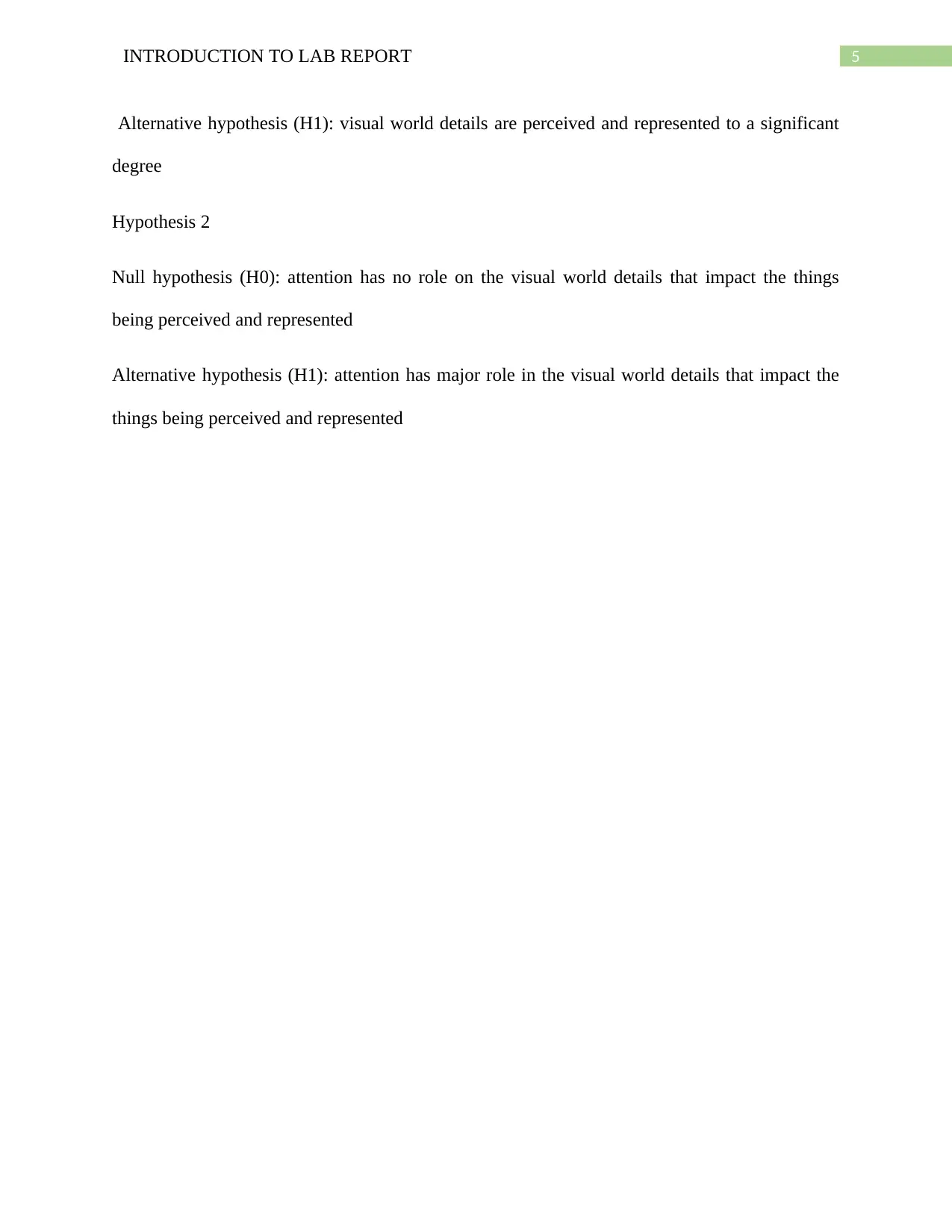
5INTRODUCTION TO LAB REPORT
Alternative hypothesis (H1): visual world details are perceived and represented to a significant
degree
Hypothesis 2
Null hypothesis (H0): attention has no role on the visual world details that impact the things
being perceived and represented
Alternative hypothesis (H1): attention has major role in the visual world details that impact the
things being perceived and represented
Alternative hypothesis (H1): visual world details are perceived and represented to a significant
degree
Hypothesis 2
Null hypothesis (H0): attention has no role on the visual world details that impact the things
being perceived and represented
Alternative hypothesis (H1): attention has major role in the visual world details that impact the
things being perceived and represented
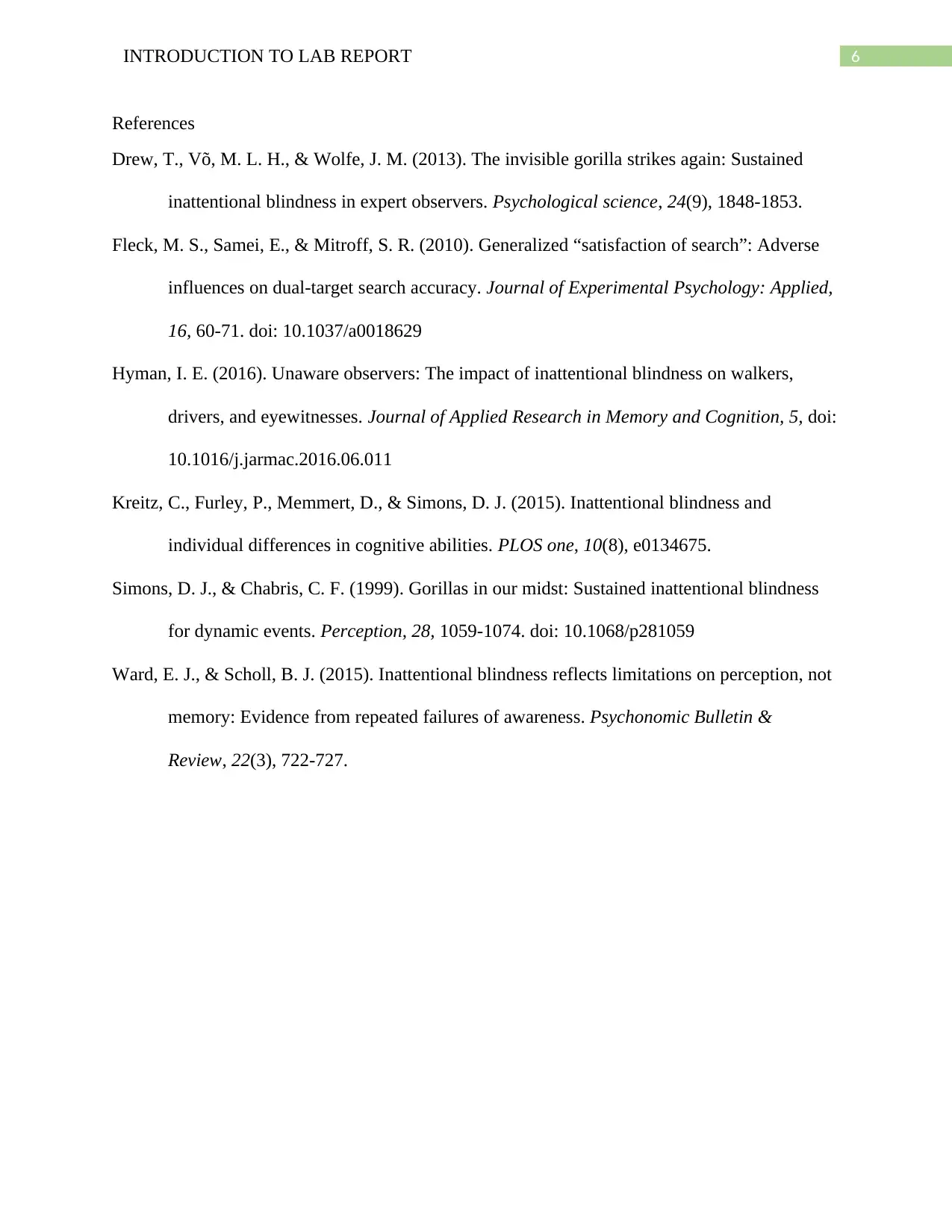
6INTRODUCTION TO LAB REPORT
References
Drew, T., Võ, M. L. H., & Wolfe, J. M. (2013). The invisible gorilla strikes again: Sustained
inattentional blindness in expert observers. Psychological science, 24(9), 1848-1853.
Fleck, M. S., Samei, E., & Mitroff, S. R. (2010). Generalized “satisfaction of search”: Adverse
influences on dual-target search accuracy. Journal of Experimental Psychology: Applied,
16, 60-71. doi: 10.1037/a0018629
Hyman, I. E. (2016). Unaware observers: The impact of inattentional blindness on walkers,
drivers, and eyewitnesses. Journal of Applied Research in Memory and Cognition, 5, doi:
10.1016/j.jarmac.2016.06.011
Kreitz, C., Furley, P., Memmert, D., & Simons, D. J. (2015). Inattentional blindness and
individual differences in cognitive abilities. PLOS one, 10(8), e0134675.
Simons, D. J., & Chabris, C. F. (1999). Gorillas in our midst: Sustained inattentional blindness
for dynamic events. Perception, 28, 1059-1074. doi: 10.1068/p281059
Ward, E. J., & Scholl, B. J. (2015). Inattentional blindness reflects limitations on perception, not
memory: Evidence from repeated failures of awareness. Psychonomic Bulletin &
Review, 22(3), 722-727.
References
Drew, T., Võ, M. L. H., & Wolfe, J. M. (2013). The invisible gorilla strikes again: Sustained
inattentional blindness in expert observers. Psychological science, 24(9), 1848-1853.
Fleck, M. S., Samei, E., & Mitroff, S. R. (2010). Generalized “satisfaction of search”: Adverse
influences on dual-target search accuracy. Journal of Experimental Psychology: Applied,
16, 60-71. doi: 10.1037/a0018629
Hyman, I. E. (2016). Unaware observers: The impact of inattentional blindness on walkers,
drivers, and eyewitnesses. Journal of Applied Research in Memory and Cognition, 5, doi:
10.1016/j.jarmac.2016.06.011
Kreitz, C., Furley, P., Memmert, D., & Simons, D. J. (2015). Inattentional blindness and
individual differences in cognitive abilities. PLOS one, 10(8), e0134675.
Simons, D. J., & Chabris, C. F. (1999). Gorillas in our midst: Sustained inattentional blindness
for dynamic events. Perception, 28, 1059-1074. doi: 10.1068/p281059
Ward, E. J., & Scholl, B. J. (2015). Inattentional blindness reflects limitations on perception, not
memory: Evidence from repeated failures of awareness. Psychonomic Bulletin &
Review, 22(3), 722-727.
⊘ This is a preview!⊘
Do you want full access?
Subscribe today to unlock all pages.

Trusted by 1+ million students worldwide
1 out of 6
Related Documents
Your All-in-One AI-Powered Toolkit for Academic Success.
+13062052269
info@desklib.com
Available 24*7 on WhatsApp / Email
![[object Object]](/_next/static/media/star-bottom.7253800d.svg)
Unlock your academic potential
Copyright © 2020–2025 A2Z Services. All Rights Reserved. Developed and managed by ZUCOL.



